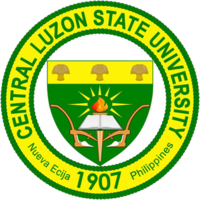This article contains promotional content. (July 2021) |
Pamantasang Pampamahalaan ng Gitnang Luzon (Filipino) | |
 The CLSU Seal | |
Former names | Central Luzon Agricultural School (1907), Central Luzon Agricultural College (1954) |
|---|---|
| Motto | Where Difference is Created |
| Type | State University |
| Established | 1907 |
| Accreditation | Accrediting Agency of Chartered Colleges and Universities in the Philippines |
| President | Hon. Evaristo A. Abella |
| Students | 10,000 |
| Location | Maharlika Highway, , , Muñoz Philippines 15°43′58″N 120°55′52″E / 15.7327°N 120.9310°E |
| Newspaper | CLSU Collegian |
| University Hymn | CLSU Hymn |
| Colors | |
| Nickname | CLSU Green Cobras/Lady Cobras |
| Website | www |
Central Luzon State University (CLSU; Filipino: Pamantasang Pampamahalaan ng Gitnang Luzon[1]) is a state university on a 658-hectare campus in Muñoz, Nueva Ecija, Philippines. It is the lead agency of the Muñoz Science Community and the seat of the Regional Research and Development Center in Central Luzon. To date, CLSU is one of the premiere institutions for agriculture in the Philippines and in Southeast Asia known for its research in aquaculture, ruminants, crops, orchard, and water management. It has also been placed between the sixth and the twenty-first spot for the most academically-excellent university in the country for various years, surpassing most schools in Metro Manila.[2][3]
CLSU is the first comprehensive state university to undergo institutional accreditation. It is a declared Cultural Property of the Philippines with the code of PH-03-0027 due to its high historical, cultural, academical, and agricultural importance to the nation.[4] It is one of the four prominent universities in Nueva Ecija and the most academically-excellent in all of Central Luzon. It is also listed as one of the most beautiful school campuses in the Philippines due to its expansive and rural-inspired forest and rice field landscapes and architectures, which focus on sustainability and ecological balance with rural and modern architectures.
- ^ Direktoryo ng mga Ahensiya at Opisyal ng Pamahalaan ng Pilipinas (PDF) (in Filipino). Kagawaran ng Badyet at Pamamahala (Department of Budget and Management). 2018. Retrieved August 24, 2020.
- ^ "100+ Best Universities in the Philippines [2023 Rankings]". EduRank.org - Discover university rankings by location. November 21, 2019. Retrieved January 9, 2024.
- ^ nair, madhu (May 15, 2019). "20 Best Universities in the Philippines". University of the People. Retrieved January 9, 2024.
- ^ "The Philippine Registry of Cultural Property". National Commission for Culture and Arts. Republic of the Philippines, National Commission for Culture and Ars. Archived from the original on August 31, 2018. Retrieved October 25, 2018.


